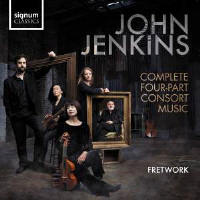Texte paru dans: / Appeared in: |
|
|
Outil de traduction ~ (Très approximatif) |
|
|
Reviewer: Barry
Brenesal The consort music of John Jenkins (1592–1678) has attracted the attention of several viol consorts in recent years, including The Consort of Musicke (Explore 10), The Spirit of Gambo (Musica Ficta 8019), and Phantasm. That last group has paid particular attention to the composer, issuing albums with his five-part (Linn 557; Fanfare 40:3, 30:6) and six-part consort music (Linn 556; Fanfare 30:2). His complete works for four-part consort, however, aren’t currently represented in the catalog, at least not by a complete recording, which leaves the field open for Fretwork.
The works themselves are conservative in the older sense of the word: They conserve a tradition in English instrumental music-making that was developed in the late 16th century, both for solo keyboard and viol consorts. It was based upon a study of counterpoint that became second nature to its practitioners, leaving composers free to explore its great possibilities in open-ended fantasias. Though Jenkins’s works don’t immediately draw the ear like the quirky musical humor of his great good friend William Lawes, his handling of part writing is so natural as to sound inevitable, and he was an inspired musician who possessed a persuasive lyrical gift.
The Puritians gifted England with a civil war and a very uncivil peace, in which many schools, homes, and churches were sacked and their contents destroyed—scores, books, instruments, furniture, paintings, and more. Attitudes towards the arts changed too, and Jenkins, who of all his musical clan lived the longest, outlived his art form. Today, though, the viol consort is alive once more, and Jenkins’s music is again drawing the attention it deserves.
I’ve also occasionally found the ensemble too restrained in the past, as noted in a review of Sit Fast’s Purcell Fantasias and In Nomines (Eloquentia 1549: Fanfare 39:6). That’s not the case here, however. A comparison in the First Fantasia with the Accademia Strumentale Italiana, which Bertil van Boer greatly enjoyed (Stradivarius 37002; Fanfare 38:6) reveals Fretwork giving far more prominence to accenting rhythms in head motifs, which in turn propels the piece along at a more insistent pace. This isn’t to suggest that the Italian ensemble is sluggish or given to under-emphasis, but while some will find their performances relaxed and even-tempered, I find them overly so in music whose expressiveness is revealed through contrapuntal conversation. The lighter fantasias, in particular the dance-like Sixth and 11th, practically kick up their heels in Fretwork’s treatment.
The sound is excellent. Don’t let the short album time, consisting of just slightly over 40 minutes a piece on two discs, drive you away either. I’ve seen this set selling for less than the price of many single CDs. Strongly recommended. | |
|
|
|
|
Cliquez l'un ou l'autre
bouton pour découvrir bien d'autres critiques de CD |
|




